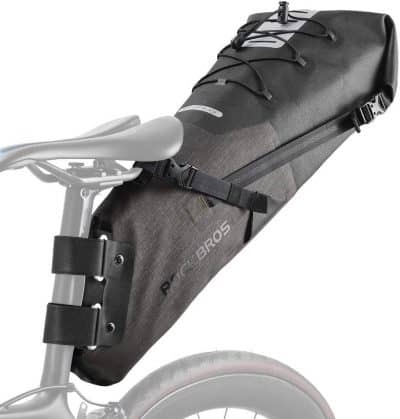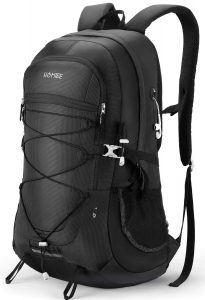In just the last decade, fat biking has grown significantly. More people than ever have invested in a fat bike to call their own, and people all around the globe are starting to see just how beneficial they can be. Not only does it open up a new type of riding on different trails, but they are dependable 12 months out of the year.
Some people are gravitating towards fat bikes for a slightly different reason. Instead of going out for a ride and coming back the same day, they are taking part in what is known as bikepacking. There is no doubt that fat bike bikepacking is on the rise, and it is a great way to see different parts of the world in a faster way than typical long-distance backpacking on foot.
Thinking about getting started but have no idea where to begin? This trend is not going away any time soon, so here are the basics of the growing activity.
What is Needed to Get Started in Bikepacking?
To get started with bikepacking, there are some basics that every person should purchase before heading out. These essentials will make life a lot easier, and there are no vulnerable situations where a person is stuck in the middle of nowhere without something essential. This is a great beginner’s checklist to make sure that everything is considered beforehand.
Fat Bike
The most obvious piece of equipment for fat bike bikepacking is a proper fat bike. Some people will opt for a traditional mountain bike, but fat bikes have shown that they are a little bit better in scenarios like this. They handle difficult terrain a better, and they are usually a more comfortable ride for beginners.
There are many different fat bike options to choose from, but most want to find something that fits the type of rider they are. Some people feel experienced enough that they go for something a little more lightweight and performance-based. Others want the most comfortable ride ever, trying to replicate the beach cruiser feel out on harsher terrains.
Remember that any fat bike is customizable after the fact, and it might be the most affordable way to go. It helps to talk to a few locals who enjoy riding fat bikes because they might be able to assist in getting the right components to make worthy upgrades.
Bikepacking Bags

Depending on how long the trip is, it is important to have a few storage solutions to count on. Most people will start with a bag that attaches to their bike, and then if more storage is needed, a traditional backpack does the trick.
There are a few different solutions to put directly on the bike, and each has its pros and cons. Some do not like a bag on their bike in certain locations, so they do what they can to avoid those.
A frame bag (Amazon) and a top tube bag (Amazon) might be the least intrusive options out there. Unfortunately, they are also the two smallest. This is for people trying to travel as lightly as possible, because not much will fit in these bags. It does do a great job of carrying the essentials, and they are easily within reach if anything is needed during the ride without stopping.
For bigger solutions, a seat bag or handlebar bag is the way to go. The biggest bags were attached to the front or back of the bike, and they are still enough out of the way to not cause any issues.
People do need to be careful about what they put in these bags, because a few things can go wrong. For starters, anything too heavy is going to weigh down the bike a bit too much.
People might be very frustrated with how much the bike weighs, and it hurts how fast a person rides on that bike. Another problem is heavy products can sink the bag and put it too low that it gets in the way of the bike functioning properly. Just be mindful of both of these scenarios, and understand that these bags are meant to store only certain items.
Find out why the ROCK BROS Bikepacking seat Bag has so many 5 star reviews on Amazon!
Backpack (optional)

Some people do not mind using a backpack at all, while others try to do whatever possible to stay away from it. There are definitely some mixed feelings as far as these bags are concerned, but most people want to stay as clear as possible from any type of added weight to their body.
The problem is, it becomes challenging to travel and carry items such as tents, tarps, and hammocks if a backpack is not used. There is only so much they can fit into the smaller bags or go on a bike, and therefore bigger items might need to go on the back.
It is still important to be very cautious about how much weight is added because it can put some stress on the body. Not only that, but a backpack added to the body is going to increase the body’s temperature quite a bit. Be prepared to sweat with a backpack attached, but there might not be a better solution.
Click here for a pretty cool Thule Backpack that I recommend from Amazon!
Clothing
It might not technically count as clothing, but the most essential item to purchase is a helmet. When putting in miles and miles of riding on some uneven terrain, the last thing a person wants to do is ride without a helmet. Always look for something built for off-road riding, as they will provide ultimate protection in case the worst happens.
For the rest of the wardrobe, there really is not a set look when it comes to fat bike bikepacking. Some people will use dry-fit material clothing, especially during the warmer months in the summer. Others will wear long sleeve tops and long pants to provide warmth, as well as protection if there is an accident. There is no doubt that an extra layer of clothing and help protect against sun rays, cuts, and bruises.
Remember that if the trail up, it gets cooler at higher altitudes. Even if it is not unusually cold at the beginning of the ride, on higher ground at night things could change significantly.
Click here for my recommended mountain bike Helmet that I own from Amazon!
Maps, tools, and other essentials

Stored in any bikepacking bags are a few essentials that everyone should have when they are on the trail. This is not only for safety purposes, but to help out others who might be out there and in need as well.
Riding long distances means that every person should travel with a way to fix a flat tire. It is one of the most common ways a person becomes derailed on their trip. Do not be stuck in the middle of nowhere without something to count on that regard.
A versatile bike tool is another way to repair most things if there is an issue along the way. Whether it be tightening up certain parts of the bike or making some subtle changes, this is something very lightweight that can go in a bag.
Do not rely solely on technology for longer rides. The phones might go dead, or there might not be a signal in remote locations. An old fashion map is exceptionally lightweight and easy to throw into any bag to offer protection if technology fails at any point.
What to Expect Early on in Fat Bike Bikepacking
Now that all the essentials are purchased and accounted for, the next step is getting out on the trails. The average bikepacker will try to cover anywhere from 20 miles to 80 miles on a typical day. For beginners, they are obviously leaning more towards the low end, so it is important to take time early on and get a general feel for how things are going. It is better to stop too early and set up camp instead of continuing and struggling to find a safe place.
That mileage might seem pretty low, especially when compared directly to a cyclist on the road. Remember the miles are a little different off-road. The pace will be a little slower, and it is more strenuous on the body as well. Depending on where a person is located, there could be some significant hills, which also play into how fast travel happens.
What are the hottest locations for bikepacking?
As one might expect, backpacking is a very regional activity at this point. Most people are going to find the majority of routes in North America in the Appalachian and Rocky Mountain ranges. There is also a significant movement in the Pacific Northwest, which is nice to see as far as growth is concerned.
Canada is also very much into fat bike bikepacking. Fat bikes, in general, have been trendy in the country throughout the years, so it makes sense to a certain degree. Trails are popping up all over, allowing newcomers to explore for the first time, and also meet people who have been bikepacking for a while.
Along with designated trails, there is also always the opportunity to create unique experiences in the wild as well. It’s usually best to leave that to those who are veterans to this type of riding, but it’s still something worth considering after learning the basics. Make sure always to check beforehand to ensure that exploration is allowed in some remote regions.
How long does bikepacking last?
The beauty of bikepacking to a lot of people is the fact that there are not a lot of rules in general. A person can pretty much decide what they want to do and how long they want to make the experience.
Some will opt to take it slow and really enjoy all the views and camping aspects of bikepacking. Others will try to cover as much ground as possible, only stopping periodically for camping to rest up.
About the only real limitation is carrying enough material for a long trip. If there are no ways to pick up additional food or other items, there is always going to be a limit before a person runs out of supplies. Other than that, it is pretty easy to become one with nature and really explore all corners of a particular area.
Why are fat bikes preferred?
Traditional backpackers might be a bit against using a bike to get around, but others are warming up to the idea. One of the reasons why a lot of people stick to going on foot is that it allows for a bit more exploration.
Fat bikes help close the gap quite a bit because they can go in a lot of places that other bikes simply can’t. A person will still have a bit more freedom to backpack the traditional way, but there are drawbacks to that as well.
The biggest drawback to traditional backpacking is that it takes a long time to travel a short distance. Some people wonder, why waste all that time and not see as much? A fat bike speeds up the traveling process, allowing for a person to see so much more in limited time.
Finally, fat bikes are a lot easier on the body than walking with a backpack on. This opens up opportunities for people who might not be in good enough or healthy enough shape to hike the traditional way. Backpacking is very challenging doing it all on foot, and it keeps some people away from exploration in general.
Start bikepacking today
For people who might still be on the fence, there are plenty of ways to get involved in bikepacking very quickly. The number one step and investment are getting a fat bike if a person doesn’t already own one.
For people who already have a fat bike, it becomes even easier to get started. Chances are, there is a trail already available for people to check out.
Go out, take it easy on the first trip and see how things go. Even as a casual activity, there is no doubt that bikepacking is here to stay as a fun activity.

